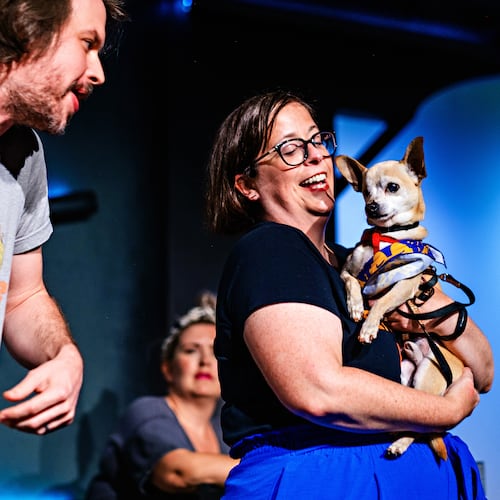Earlier this week, a video went viral featuring 17-year-old high school senior Claire Crawford collapsing from sudden cardiac arrest in the middle of a volleyball game.
The video was featured on Children's Healthcare of Atlanta's Facebook page. More than 12 million viewers have seen the startling video of Claire collapsing at the gym of her school, Lower School Academic Dean at Loganville Christian Academy. The incident took place in October of last year, and until now, viewers of the video had not yet heard from the person who kept her alive.
But as a guest writer on Children's Healthcare of Atlanta's Blog, Julie Sirmans, Lower School Academic Dean at Loganville Christian Academy, answers the question: What is it like, in the moment, to save a life?
Here is an excerpt from the blog (shared here with permission).
I am not a medical professional. I am a teacher. But on a fateful night in a school gym, I learned that one’s title does not affect one’s ability to help save a life.
With three daughters who love volleyball and play year-round, I have attended more matches than I can count. There are things you come to expect at every game—exceptional digs, well played hits and strategically placed sets. What you don’t expect is to watch a 17-year-old grab her chest and collapse right before your eyes.
But that’s exactly what happened on a Tuesday night at Loganville Christian Academy (LCA).
As a member of the academic administration at LCA, I have been a part of our Code Blue Response Team since 2006. With the help of Project S.A.V.E., a team of 16 school employees—ranging from administrators to teachers to our CFO—have been trained to use automated external defibrillators (AEDs). An AED is a portable device that checks the heart’s rhythm and can send an electric shock to the heart to restore normal rhythm. More specifically, AEDs are used to treat sudden cardiac arrest.
For the past seven years, we’ve participated in drills at least three times a year that tasked us with responding to codes at various locations throughout campus, from the parking lot to our lunchroom.
This training prepared me for the life-changing event that took place Oct. 13 shortly after 6 p.m. Claire Crawford, one of our players, had just served the ball to the opposing team and moved into her position by the net as the setter.
The chilling sound of her fall still rings in my mind today. Claire’s parents, Eric and Lisa, were the first to arrive at her side. I stayed back for a moment, giving them space, as we all thought she had passed out. Immediately, Mallory McQuaig, the athletic trainer, and Telessa Kendell, a teammate’s mother, rushed to her side and began to access her vitals. No pulse. No heartbeat. No breathing. No color.
I looked at someone in the concession stand and told them to call 911 as I was running for the AED. Luckily, the AED was only 35 short steps away from where Claire had fallen which allowed us to have the AED by her side within 32 seconds.
People have asked me a thousand times what those next few minutes were like. Despite years of CPR and AED training, I was nervous. Very nervous. I was literally watching life withdraw from this child—a child I’d watched blossom into a high school senior, star student and accomplished athlete over many years.
Time slowed to a crawl. In my mind, everything played out over about 10 minutes. There is a video that dispels my notion of timing and cuts everything almost in half. That night happened to be Senior Night, and Claire’s parents just happened to have a video camera set up to record the game. That video camera captured the entire experience.
Thanks to the video, we know this to be the approximate 4.5-minute timeline of key moments:
:00 Claire grabs chest
:03 Claire hits floor
:16 911 called
:32 AED arrives
:56 CPR begins
1:17 AED turned on
1:43 Pads applied
1:58 AED analyzing begins
2:18 AED advises a shock
2:23 AED advises a shock
2:26 AED administers 120 joules
2:30 CPR continued
3:27 CPR discontinued
4:29 Life returns
Did you notice that “advises a shock” has two entries? The AED gave the first command to administer a shock at 2:18. But in that very moment, I froze.
Despite my years of training and the verbal reinforcement from the AED to administer the shock, I doubted myself and the machine. The device is no joke; it can deliver several hundred joules of power. Was I, a teacher with no formal medical training, really capable of following through with this? Could I really trust this machine to the make the right call?
I looked across Claire’s lifeless body and straight into the eyes of our athletic trainer who had been administering CPR. I said, “It’s telling me to shock her.” She looked me in the eye and, without hesitation, told me to press that button. Her reassurance was invaluable. In fact, it gave me the confidence I needed to push the flashing button. Five seconds later, the device again advised me to administer a shock.
This time, I pressed that button.
That was the turning point. After additional CPR, color returned to Claire’s cheeks. Her eyes opened. She began breathing and making noise. Her first words were, “Oh no! Did I pass out?”
The joy and relief that filled our hearts in that moment cannot be put into words.
We did it.
About the Author
Keep Reading
The Latest
Featured


